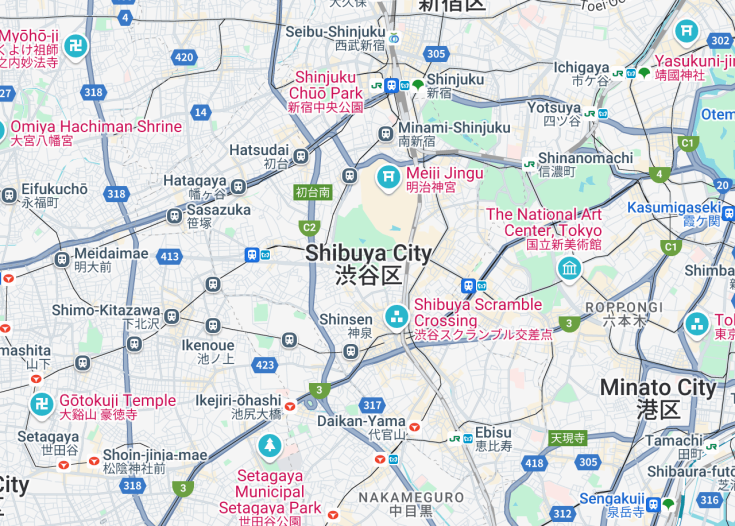Shibuya, a vibrant and pulsating heart of Tokyo, is celebrated for its bustling streets, trendsetting fashion, and iconic Shibuya Crossing, where waves of pedestrians crisscross in a mesmerizing dance of urban life. This district is not only a commercial hub but also a launching pad for new styles and cultural trends, making it a barometer for contemporary Japan. Visitors can explore everything from cutting-edge technology stores to tranquil parks like Yoyogi, offering a multifaceted urban experience that encapsulates the dynamism and innovation of Tokyo.
For an unforgettable experience, visit Shibuya at night to see the area illuminated in neon lights, providing a spectacular backdrop for your Tokyo adventures.
Consider exploring the lesser-known backstreets of Shibuya to discover unique boutiques and cozy cafes that offer a more intimate glimpse into local life.
Top things to do & see in Shibuya
Select the following sights and activities to discover best tickets and tours available in Shibuya.
Shibuya: Unveiling Urban Vibrancy
| Country | Japan |
| Time in Shibuya | GMT+9 |
| Language spoken | Japanese |
| Population | 2,376,000 (Source: Tokyo Metropolitan Government) |
| Currency | Japanese Yen (¥, JPY) |
| Airports |
|
Shibuya, in the heart of Tokyo, is a vibrant hub known for its youthful energy and bustling atmosphere. Its streets are filled with an array of shopping destinations, entertainment options, and cultural experiences. Shibuya is a significant commercial and business district and is popular for its landmark Shibuya Crossing, the world’s busiest pedestrian crossing. Among the neighborhood’s notable places are Hachiko statue, Shibuya 109 building, and Yoyogi Park. Shibuya also serves as a major connecting point for various railway lines, facilitating easy access to and from other districts of Tokyo. Shibuya’s development from a humble village to a major urban center showcases Tokyo’s rapid urbanization and cultural globalization. Each corner of Shibuya has its unique charm that reflects both modern trends and traditional practices, making it a fascinating area for both locals and tourists to explore.
Where is Shibuya?
Shibuya is a special ward located in the western part of Tokyo, Japan, renowned for its bustling cityscape and iconic street crossings.
Distances:
| Route | Distance by car | Time by car |
|---|---|---|
| Tokyo to Shibuya | 5.5 miles (9 km) | 25 mins |
| Yokohama to Shibuya | 18 miles (29 km) | 40 mins |
| Chiba to Shibuya | 32 miles (52 km) | 1 hr 10 mins |
What is Shibuya famous for?
Shibuya is famous for its iconic Shibuya Crossing, trend-setting fashion scene, and vibrant nightlife. It’s a cultural landmark that epitomizes the dynamic and youthful spirit of Tokyo.
History
Pre-20th Century
Shibuya’s history begins long before it became a global icon of urban Japanese culture. Originally a quiet and unassuming village situated at a crucial meeting point of ancient roads, Shibuya’s existence can be traced back to the 11th century. It was primarily used as a layover spot for travelers, gradually developing into a bustling community.
1900-1945: Expansion and War
The early 20th century marked a period of rapid transformation for Shibuya. The construction of Shibuya Station in 1885 facilitated its growth, turning the area into a prominent commercial and entertainment hub. However, World War II brought significant destruction to Shibuya, with many of its buildings damaged during air raids.
1945-2000: Post-War Development and Tech Boom
After World War II, Shibuya became a symbol of Japan’s recovery and modernization. The 1950s and 60s saw the rise of Hachikō – the loyal dog, which became a national symbol of fidelity, epitomized by the famous statue outside the Shibuya station. The latter half of the 20th century saw Shibuya at the forefront of Japan’s technological and economic boom, with numerous tech companies setting up their headquarters in the district.
2001-Present: Cultural Pinnacle
The 21st century cemented Shibuya as a focal point for youth culture, fashion, and nightlife. Renowned as a trendsetting locale, it continues to capture the world’s imagination with its vibrant street life, innovative architecture, and bustling scenes. Landmark projects such as Shibuya Sky and the transformation of the Shibuya station area have kept the district both contemporary and iconic.
Visit Shibuya
What to see and do in Shibuya, Japan
Exploring Shibuya is like stepping into a whirlwind of activity where tradition meets hyper-modernity. Must-visits include the iconic Shibuya Crossing, billed as the busiest pedestrian crossing in the world; the Hachikō statue, a beloved symbol of loyalty; and Yoyogi Park, a peaceful retreat from the city’s hustle. Dive into the creative scene at the Design Festa Gallery, or fashion aficionados can scour the boutiques of Shibuya 109. Don’t miss:
- Shibuya Sky: Offering panoramic views of Tokyo.
- Nonbei Yokocho: Savor local eats in a quaint alleyway atmosphere.
- Shibuya Cultural Center Owada: Catch cultural performances and arts.
Festivals and Events in Shibuya
Shibuya is renowned for its vibrant festivity scene, particularly highlighted during the Shibuya Halloween, when the streets transform into a spectacular costume parade. The Shibuya Station area is a theatre of color and creativity around this time in October. The New Year’s Eve celebrations are another major event, drawing revelers for the famous countdown.
Best time to visit Shibuya
While captivating year-round, the best times to visit Shibuya are either during the cherry blossom season of late March to early April when the city is in a festive mood, or during the autumn months of October and November when the weather is mild and conducive for exploring its endless outdoor activities.
Is Shibuya worth visiting?
Shibuya is unquestionably worth visiting for anyone drawn to the pulsating heart of a modern metropolis infused with rich cultural undertones. This neighborhood offers an immersive experience into Japanese urban life, its dynamic youth culture, and innovation. Whether for shopping, dining, or cultural exploration, Shibuya presents an endlessly dynamic urban tapestry that’s both vibrant and deeply ingrained with Japan’s unique ethos.









